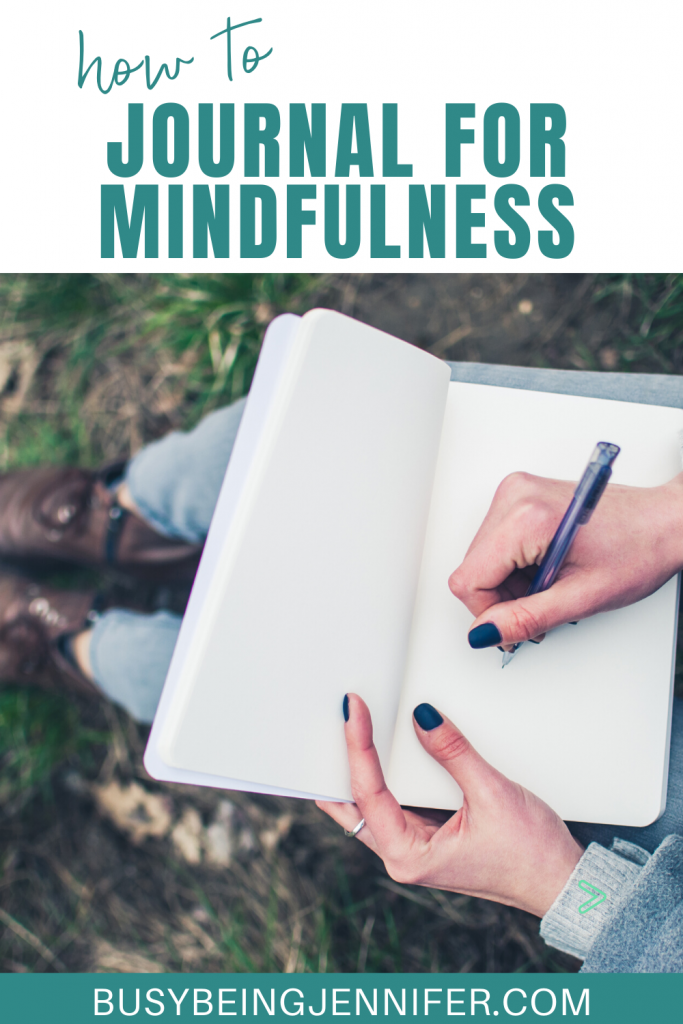Mindfulness has the potential to transform your life. It can help you become more productive, more content, and less stressed. Journaling is a great way to practice mindfulness, and you just need a notebook and a pen to get started. In this post I’m going to share with you how you can journal for mindfulness. Also, keep reading to learn how to do a brain dump!

How to Journal for Mindfulness:
Dig Into Sensory Details
Mindfulness is all about paying attention to the physical world around you. If you’re stuck on what to write about, focus on something you saw, heard, tasted, smelled, or felt recently. Try to pin down the sensory details of the experience.
Focus on Gratitude
What are you thankful for? Write about it in your mindfulness journal. Gratitude and mindfulness go hand-in-hand – they’re both about slowing down and appreciating what you’ve got in the here and now. Journaling happens a lot easier when you are focused on gratitude.
Get Creative
If you don’t feel like writing a traditional journal entry, then don’t. It’s fine to draw pictures, make lists, or write poems in your mindfulness journal. Do what works for you. You will be amazed at how much easier journaling is when you don’t have pressure to be creative.

Avoid Putting Pressure on Yourself
If you’re a perfectionist about your journal, stop! There’s no right or wrong way to keep a journal. No one else has to read it. It’s okay to write boring entries, spell things wrong, and use messy handwriting. Your journal is for you and no one else. So, stop putting pressure on yourself and relax.
Use Your Memories
Reflecting on memory can be a good exercise in mindfulness. Pick a memory and try writing down all the sensory details you can remember about it. For example, how did the sun feel on your skin during your vacation last year?
If you have lingering emotions surrounding the memory, put those in your journal too. You can do this exercise with big memories, but reflecting on your small memories can be valuable as well.

Notice Your Self Talk
Are you in the habit of noticing the dialogue inside your head? If not, your mindfulness journal is a good place to capture your self-talk. Have you ever noticed negative self-talk?
Negative self-talk, like “I’ll never get this right,” can hurt your self-esteem and make you less productive. You may not even be aware that you’re doing it. On the other hand, positive self-talk – such as “I work really hard” is a good thing. This kind of positive talk can help you with your mindfulness journey.
Make Journaling Part of Your Routine
Like any other healthy habit, you’ll get more out of journaling if you do it regularly. Set aside a regular time every day or week to write in your mindfulness journal. Some people do better when they journal every single day. Others do better when they journal less.
Journaling is a simple, accessible way to get in touch with yourself and live in the present moment. If you want to boost your mood and your productivity, you can take the first step by starting a mindfulness journal today.
What if you can’t get in the mood to journal? Something I like to do every now and again is a brain dump!

What is a Brain Dump?
If you’re like most people with an active mind, those thoughts can be overwhelming at times. It’s hard to move past those thoughts and find a sense of peace that comes from a still mind. But one of the best ways to clear your head is by utilizing a brain dump.
A brain dump is exactly as it sounds: you take the thoughts that are in your head and dump them onto another storage device, like a journal or a piece of paper.
The brain can only process a fraction of what’s inside your brain at any one time, so removing them from active memory to a place where you can see and recall them at any time helps the body feel relaxed and increases your productivity. No longer are you worried about what you’re going to make for dinner, now the only thing that matters is the task at hand.
Reasons to Consider a Brain Dump
The benefits of a brain dump can be enormous.
- You’ll regain clarity and peace of mind that may have eluded you.
- You’ll feel more in control of your life, you’ll regain some of those still thoughts that were missing from your life, and you might even attain a deeper level of sleep and relaxation.
- Your productivity will skyrocket now that you have all the extra space and freedom to think about what you need to think about.
How to Do a Brain Dump
If you’ve never done a brain dump before, it’s remarkably easy, although it may take some time to get the hang of it.
Step 1 – Grab a journal or notebook, and begin to write the words that come to your mind freely and quickly.
Step 2 – Don’t worry about grammar or word choice or even spelling, just put whatever comes to your mind on the paper as fast as you can.
Step 3 – Depending on how full your mind is, you may end up with anywhere from one paragraph to ten pages, but no matter what, get those thoughts out of you!
Step 4 – This process is called freewriting. Authors use it all the time when they encounter a mental block, in life, it’s no different.
Doing a brain dump can actually be a better journaler. It can help you learn how to journal for mindfulness and is one of the most powerful tools for centering yourself!

These might seem like pretty simple ideas, but being able to journal for mindfulness and utilizing the occasional brain dumps have been game changers in my personal mindset journey.
It’s also cool to have a record of sorts to reflect back on and see just how far I’ve progressed over the years too!
Have you tried to journal for mindfulness? When was the last time you did a brain dump?

Leave a Reply